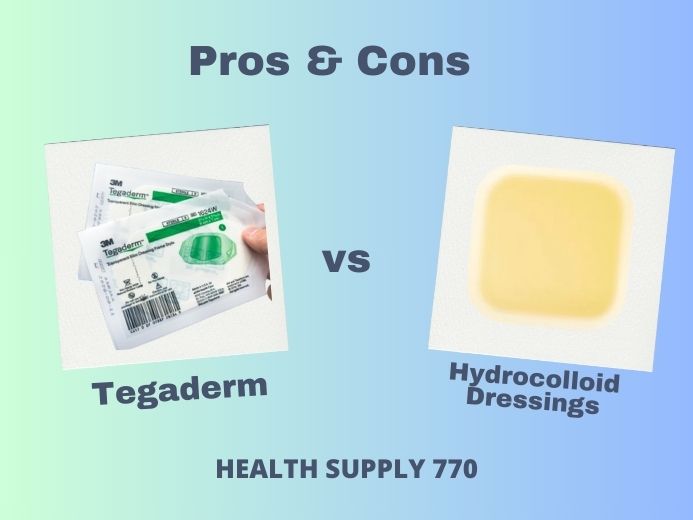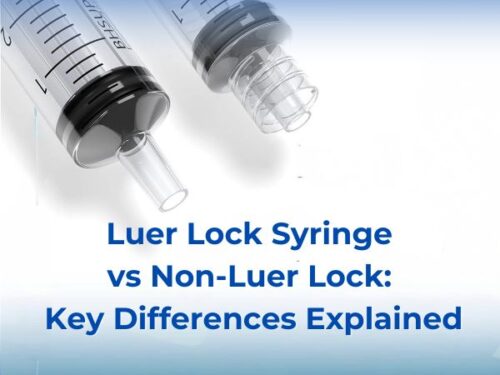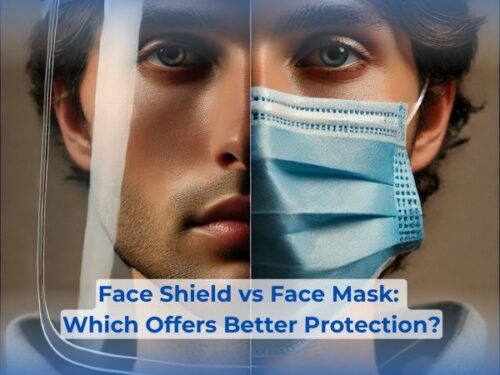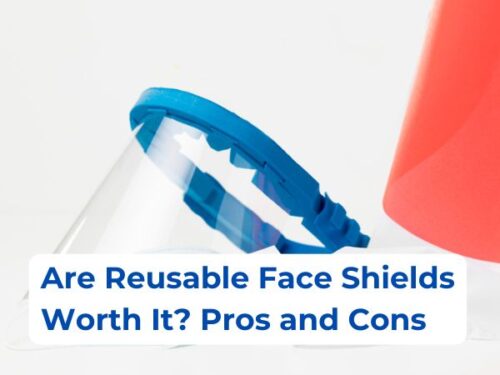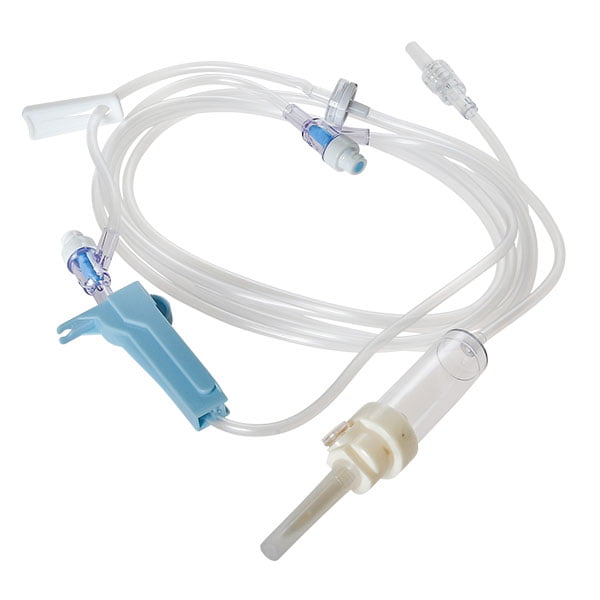Tegaderm vs. Hydrocolloid Dressings: Pros and Cons for Different Wound Types
Dressing material is one of the essential items used in healthcare. Primary and secondary dressing items assist in covering wounds, IV injection sites, catheter points, etc. Among these, Tegaderm and hydrocolloid dressings are a few of those consumable items that are often employed in home settings as well as in healthcare facilities. Let us dive deeper into their roles, uses, and pros and cons along with their suitability for different types of wounds.
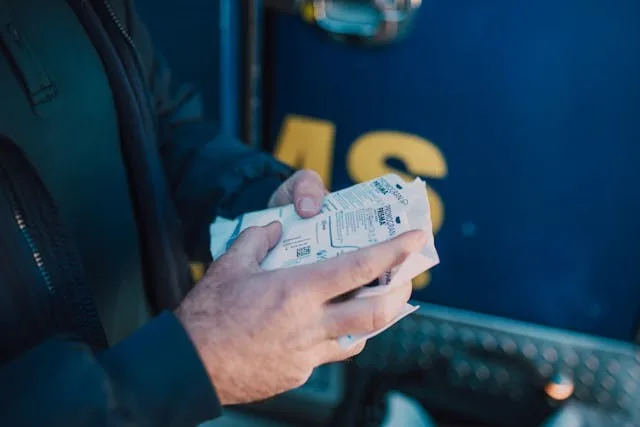
Tegaderm Dressing
Tegaderm dressings by 3M are one of the widely used medical consumables. These are sterile films that are intended to be employed either on the IV injection site or as a wound dressing for covering the affected area. As the product is disposable, each Tegaderm transparent dressing is to be used once only.
Characteristic Features of Tegaderm Films
The Tegaderm patches by 3M have the following characteristic features:
● Tegaderm films are disposable which means these are single-use items.
● These dressings come as a sterile product that is opened at the time of application.
● Tegaderm patches are waterproof which makes them suitable for day-to-day use. Moreover, these dressings do not get affected by the fluids at the site of injury.
● As their material is highly breathable, the Tegaderm patches do not irritate the skin. Rather, these allow the passage of air in and out of the affected area resulting in effective drying.
● As these films are transparent, they allow the visualization of the IV injection site.
● These Tegaderm dressings come in different shapes and sizes which makes them suitable for all.
● As the Tegaderm patches are radiologically transparent, there is no need to remove them while doing an X-ray of the site.
● All the Tegaderm dressings are hypoallergic and completely free from latex which makes them suitable for use in patients with sensitive skin as well.
Indications and Uses of Tegaderm Transparent Film Dressings
The Tegaderm dressings can be used in the following indications:
● On wounds with little to no exudate as wound dressings
● Catheter sites
● IV injection sites
● Sacral wounds
● Lightly draining wounds
● Areas affected with burns
● Stitched site after a surgical procedure
● Donor sites
Pros
The Tegaderm dressings have the following advantages:
● Tegaderm transparent dressings can be employed to cover minor wounds such as blisters, abrasions, as well as skin tears.
● These films are also suitable for covering the skin-grafted donor sites.
● For the protection of stage I and II pressure ulcers, Tegaderm patches can be used.
● The product is also efficient in acting as a barrier against moisture which makes it a suitable dressing for the IV sites. This way, the process of wound healing is sped up.
● Tegaderm dressings also increase autolytic debridement resulting in the breakdown and clearing of the damaged cells from the site of injury.
● Tegaderm transparent dressings can be paired with primary dressings such as alginates, gauze, hydrogels, etc. Here, acting as a secondary dressing, the Tegaderm dressings provide greater protection to the wounded area.
Cons
The Tegaderm transparent dressing comes with the following disadvantages:
● Being single-use products, the Tegaderm dressings are not suitable for sterilization or reuse.
● Their long-term use might cause irritation and redness on the site of application in patients who have sensitive skin.
● These are not suitable for wounds with moderate to heavy exudate.

Hydrocolloid Dressing
Hydrocolloid dressings are occlusive or non-occlusive wound dressings that are known to provide a moist environment to the affected area with the aim of shortening the healing time. These hydrocolloid dressings are prepared by mixing hydrogel with synthetic rubber and other sticky materials that can hold the assembly together.
In addition, other ingredients include gelatin, polysaccharides, pectin, as well as sodium carboxymethyl cellulose (CMC). By nature, these dressings come in the form of paste, gel, powder, wafers, or sheets some of which also require a secondary dressing material to hold them in place.
Characteristic Features of Hydrocolloid Dressings
Hydrocolloid dressings provide the following characteristic features:
● These hydrocolloid dressings are impermeable to gases, water, vapors, bacteria, as well as other contaminants.
● The product has the property of maintaining a moist environment by gelling on contact with exudate.
● Hydrocolloid dressings are water-resistant which renders them suitable to be worn in the shower as well.
● These dressings are suitable to be paired with compression products.
● As the hydrocolloid dressings are moldable, they can adjust according to the wound on which it is applied.
● These dressings can be cut and re-shaped according to the patient’s needs.
● Hydrocolloid dressings are self-adherent which means the film dressing adheres firmly in place and does not slip away from the affected area.
● Hydrocolloid dressings are non-adherent to moist basis which increases patient comfort.
● The product can be worn for up to a week.
Indications and Uses of Hydrocolloid Wound Dressings
Hydrocolloid dressings are ideal in the following conditions as a primary or a secondary dressing aid:
● Dermal ulcers
● Skin tears
● Lacerations
● Pressure injuries
● Wounds with necrotic tissue
Pros
Hydrocolloid dressings have the following uses as well as advantages:
● Hydrocolloid dressings have excellent exudate absorption properties that make them the first choice for wounds with heavy exudate.
● Hydrocolloid dressings are ideal for pressure injuries.
● Hydrocolloid dressings are suitable for patients with incontinence as these effectively protect the skin of the appendix from getting infected and improve tissue tolerance.
● These dressings are also preferred for dressing venous ulcerations.
● Hydrocolloid dressings also promote autolytic debridement which helps in clearing the wounded area from cell debris.
Cons
Hydrocolloid dressings are not suitable for the following:
● Burns
● Dry wounds
● Infected wounds
● Tunneling wounds
● Areas with exposed tendons or bone
● Wounds with fragile skin around the damaged area
● Full-thickness wounds
Difference between Tegaderm and Hydrocolloid Dressing
From their construction to their utilization, the Tegaderm and hydrocolloid dressings differ in many things. The following table enlists a comparison of both:
| Parameters | Tegaderm Dressings | Hydrocolloid Dressings |
| Sterility | ✔ | ✔ |
| Impermeability to external contaminants | ✔ | ✔ |
| Water-resistance | ✔ | ✔ |
| Autolytic debridement | ✔ | ✔ |
| Readjustment of size and shape | ✔ | ✔ |
| Wound inspection | ✔ | ✔ |
| Ideal for wound-type | IV injection site and catheter insertion points | Wounds with heavy exudate and pressure injuries |
| Cost-effectiveness | ✔ | ✔ |
Wound Dressings: Brands and Specifications
In the US market, multiple brands are manufacturing and marketing wound dressings. Their versatility enables patients with different kinds of wounds to choose a product that serves them best and is also ideal for the type of wound under question. The following are some of the best wound dressings along with their specifications:
3M Tegaderm Dressing Transparent Film Roll
3M Tegaderm 16006 dressing transparent film roll is a waterproof product that is sterile and acts as a perfect barrier against environmental contaminants when applied to a wound. The product is made from a virtually transparent material and has also been tested and proven effective against viral contamination. The product can be used to cover any kind of wound as it can be cut in a suitable length based on the patient’s needs. As the material is flexible, it flexes once applied to a wound and enhances patient comfort.
3M Tegaderm Transparent Film Frame Dressing
1622W 3M Tegaderm dressing transparent film frame is a sterile consumable medical product. It is waterproof and has the capacity to remain intact in its place without leakage. The product is effective against all kinds of microbial agents including viruses, bacteria, and other pathogens. In addition, the dressing also protects against blood and body fluids. The film is breathable which means the area which is covered by it does not get irritated. Due to its picture-frame design, the dressing tends to remain undisturbed in place for longer.
3M Tegaderm Transparent Adhesive Film Dressing
3M 1626W Tegaderm transparent adhesive film dressing is a product that is often employed on the IV site as well as a wound dressing. In addition to having the above-mentioned features, the transparency of the product allows continuous visibility of the IV insertion site. These Tegaderm films are also radiologically transparent. Moreover, the product can be worn for up to 7 days. Furthermore, these films are also not irritant to the skin.
3M Tegaderm Adhesive Foam Dressing
3M 90610 Tegaderm adhesive foam dressing has a multi-layer construction. The product is efficient in managing the fluid as it can prevent any leakages over long-term use. The product offers a one-handed application that enables the healthcare provider or the patient to use it easily. As the Tegaderm adhesive foam dressing is waterproof, it can also be worn while taking a shower. Moreover, these Tegaderm adhesive foam dressings cause minimal skin irritation and thus are comfortable for the patient to wear.
DuoDerm CGF Hydrocolloid Dressing
CGF hydrocolloid dressing by DuoDerm is manufactured by Convatec. The product comes in a beige color and 4 x 4 dimensions with a square or rectangular shape. It comes in sterile packaging and can be applied to different kinds of wounds.
HealQu Hydrocolloid Dressing Border
HealQu 9020801 hydrocolloid dressing border is a highly absorbent product made with non-irritant material. It effectively prevents the leakage of wound exudates thus balancing the moisture content near the wound. The product is latex-free which makes it suitable for people with latex allergies.
Dynarex DynaDerm Hydrocolloid Dressing
Dynarex DynaDerm hydrocolloid dressing has an extra-thin texture that increases patient comfort. Being sterile, the product also helps in preventing infections. It is 6” x 6” in size and is suitable for use in areas that have a delicate texture. It also facilitates autolytic debridement and thus enhances the healing process.
Gentell GEN-10200 Dermatell Hydrocolloid Dressing
Gentell GEN-10200 Dermatell hydrocolloid dressing is a sterile, waterproof, and latex-free product. It has high adhesive strength that makes it suitable to be applied on difficult-to-dress areas. Each of the Gentell hydrocolloid dressings comes in individualized packaging to ensure sterility. These are highly effective in preventing leakage from the wounded area.

The Tegaderm as well as hydrocolloid wound dressings mentioned in this article, along with many other medical supplies, can be purchased from Health Supply 770, a reliable name when it comes to medical products. They have a 30-day money-back guarantee and provide your products to you in the shortest possible time. Click the link at the end of the article to check the wide range of wound dressings on the website.
The Bottom Line
In healthcare setups, the consumption of dressings is high due to their extensive applications. In this regard, hydrocolloids as well as film dressings are often employed. Their flexible and comfortable design not only makes the user experience good but also prevents them from external contaminants as they completely shield microbes and other infection-causing agents.
Moreover, Tegaderm is a transparent dressing that also enables the physician to inspect the wound without removing it. Overall, both the products have their own suitability and utility and an appropriate dressing should be chosen based on the type of wound.
Purchasing medical devices from reliable vendors like Health Supply 770 ensures the provision of quality products along with satisfactory services.
Click to Order from Health Supply 770
References
https://www.ncbi.nlm.nih.gov/pmc/articles/PMC7096556/

PhD Scholar (Pharmaceutics), MPhil (Pharmaceutics), Pharm D, B. Sc.
Uzma Zafar is a dedicated and highly motivated pharmaceutical professional currently pursuing her PhD in Pharmaceutics at the Punjab University College of Pharmacy, University of the Punjab. With a comprehensive academic and research background, Uzma has consistently excelled in her studies, securing first division throughout her educational journey.
Uzma’s passion for the pharmaceutical field is evident from her active engagement during her Doctor of Pharmacy (Pharm.D) program, where she not only mastered industrial techniques and clinical case studies but also delved into marketing strategies and management skills.










